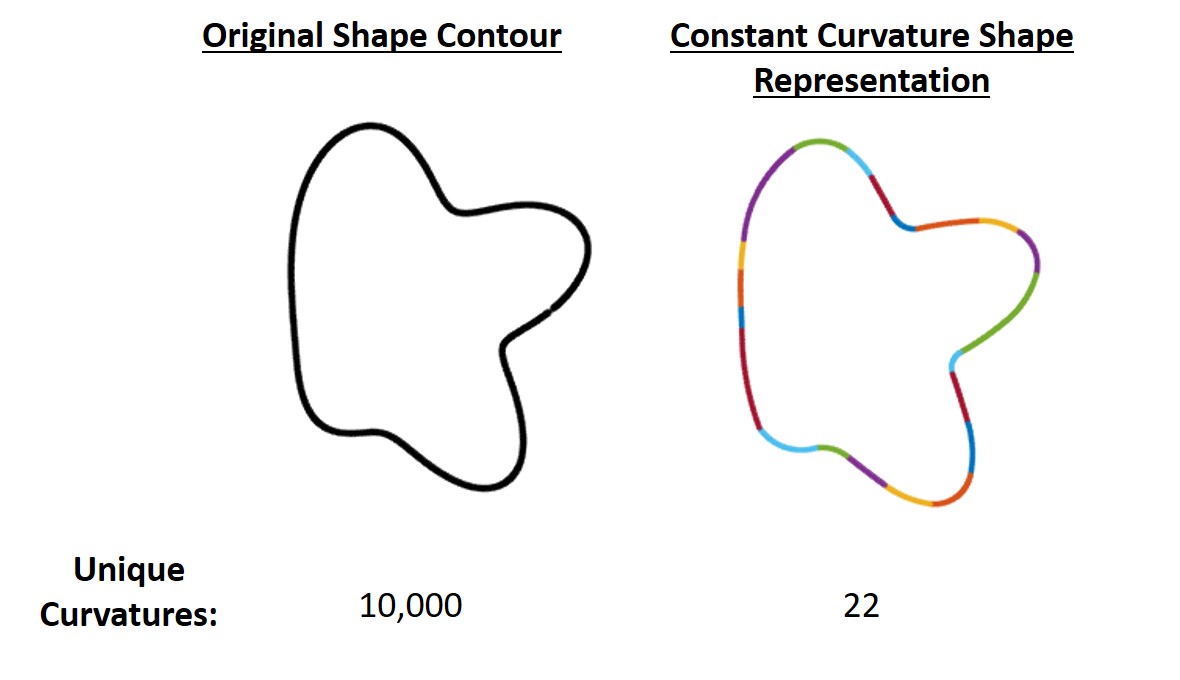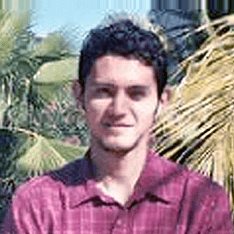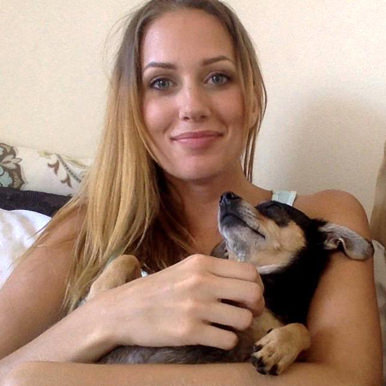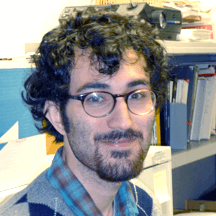Visual Perception and Representation of Shape
Shape is a crucial source of information for identifying and inferring the functional properties of an object. Classic work dating back to the Gestalt psychologists has shown that the information we encode about an object’s shape is different from the sum of all visual elements present during sensation. For example, we often see clouds shaped like horses or other objects even though there is very little similarity between the physical features of a horse and any cloud. We study the information processing systems by which sensory elements are transformed into shape representations.
How does the visual system encode information present in sensation into more abstract, symbolic descriptions of shape? Abstract shape representations should be more informationally compact than the physical contours of objects while still preserving contour information that is essential to an object’s shape. One hypothesis we are investigating is that the visual system segments contours into regions of similar curvature and represents a shape as a relatively constrained set of smoothly connected constant curvature segments.
Arrangements of unconnected dots sometimes give rise to shape percepts despite having no explicit orientation or curvature information. We study the geometric relationships between dots that result in a shape percept. These simplified dot displays can also be informative about what visual information is used in encoding the shape of an object. For example, changing the position of individual dots along a virtual shape contour reveals very little sensitivity in the visual system to local feature changes.

Spatiotemporal Boundary Formation
-
Spatiotemporal Boundary Formation - Scaling + Rotation -
Spatiotemporal Boundary Formation - Non-Rigid Transformation
Researchers
-
 Philip J. Kellman
Philip J. Kellman -
 Everett Mettler
Everett Mettler -
 Suzy Carrigan
Suzy Carrigan -
 Nicholas Baker
Nicholas Baker
Collaborators
-
 Gennady Erlikhman
Gennady Erlikhman -
 Jennifer Mnookin (UCLA)
Jennifer Mnookin (UCLA) -
 Itiel Dror (UCL)
Itiel Dror (UCL) -
 Hongjing Lu (UCLA)
Hongjing Lu (UCLA) -
 Patrick Garrigan (SJU)
Patrick Garrigan (SJU) -
 Brian Keane (Rutgers)
Brian Keane (Rutgers) -
 Tandra Ghose (TU Kaiserslautern)
Tandra Ghose (TU Kaiserslautern)
Selected Publications
- Baker, N., & Kellman, P. J. (2024). Shape from dots: a window into abstraction processes in visual perception. Frontiers in Computer Science, 6, 1367534.
- Kellman, P. J., Baker, N., Garrigan, P., Phillips, A., & Lu, H. (2023). For deep networks, the whole equals the sum of the parts. Behavioral and Brain Sciences, 46, e396.
- Baker, N. & Kellman, P.J. (2023). Independent mechanisms for processing local contour features and global shape. Journal of Experimental Psychology: General. 152(5), 1502–1526.
- Baker, N., Garrigan, P., Phillips, A., & Kellman, P. J. (2023). Configural relations in humans and deep convolutional neural networks. Frontiers in Artificial Intelligence, 5, 961595.
- Mroczko-Wasowicz, A., O'Callaghan, C., Cohen, J., Scholl, B., & Kellman, P. J. (2023). Advances in the study of visual and multisensory objects. In Proceedings of the Annual Meeting of the Cognitive Science Society (Vol. 45), 32-33.
- Kellman, P. J., & Fuchser, V. (2023). Visual completion and intermediate representations in object formation. To appear in A. Mroczko-Wąsowicz and R. Grush (Eds.), Sensory Individuals: Unimodal and Multimodal Perspectives (pp. 55-76). NY: Oxford University Press.
- Phillips, A., Erlikhman, G., Fuchser, V. & Kellman, P. J. (in preparation). Path integration and illusory contours: Evidence for an intermediate representation in visual contour interpolation.
- Baker, N., & Kellman, P. J. (2021). Constant curvature modeling of abstract shape representation. PLOS ONE, 16(8): e0254719.
- Baker, N., Garrigan, P., & Kellman, P. J. (2020). Constant curvature segments as building blocks of 2D shape representation. Journal of Experimental Psychology: General. Advance online publication. https://doi.org/10.1037/xge0001007
- Baker, N., Lu, H., Erlikhman, G., & Kellman, P.J. (2020). Local features and global shape information in object classification by deep convolutional neural networks. Vision Research, 172, 46-61. doi: 10.1016/j.visres.2020.04.003
- Baker, N., Lu, H., Erlikhman, G., & Kellman, P.J. (2018) Deep convolutional networks do not classify based on global object shape. PLOS Computational Biology, 14(12), e1006613. doi: 10.1371/journal.pcbi.1006613
- Baker, N., Kellman, P. J., Erlikhman, G., & Lu, H. (2018). Deep convolutional networks do not perceive illusory contours. In T.T. Rogers, M. Rau, X. Zhu, & C. W. Kalish (Eds.), Proceedings of the 40th Annual Conference of the Cognitive Science Society (pp. 1310-1315). Austin, TX: Cognitive Science Society.
- Baker, N. & Kellman, P.J. (2018). Abstract shape representation in human visual perception. Journal of Experimental Psychology: General. Advanced online publication. doi: 10.1037/xge0000409
- Palmer, E. M., & Kellman, P. J. (2017). The aperture capture illusion. In D. Todorovic & A. G. Shapiro (Eds.), Oxford compendium of visual illusions. NY: Oxford University Press.
- Carrigan, S. B., Palmer, E. M., & Kellman, P. J. (2016). Differentiating global and local contour completion using a dot localization paradigm. Journal of Experimental Psychology: Human Perception and Performance. Advanced online publication. doi: 10.1037/xhp0000233
- Erlikhman, G., & Kellman, P. J. (2016). From flashes to edges to objects: Recovery of local edge fragments initiates spatiotemporal boundary formation. Frontiers in Psychology, 7, 910.
- Erlikhman, G., & Kellman, P. J. (2015). Modeling spatiotemporal boundary formation. [Special issue on quantitative approaches in Gestalt perception]. Vision Research, 126, 131–142.
- Erlikhman, G., Xing, Y. Z., & Kellman, P. J. (2014). Non-rigid illusory contours and global shape transformations defined by spatiotemporal boundary formation. Frontiers in Human Neuroscience, 8, 1-13.
- Ghose, T., Liu, J., & Kellman, P. J. (2014). Recovering metric properties of objects through spatiotemporal interpolation. Vision Research, 102, 80-88.
- Kellman, P. J., Mnookin, J., Erlikhman, G., Garrigan, P., Ghose, T., Mettler, E., Charlton, D. & Dror, I. E. (2014). Forensic comparison and matching of fingerprints: Using quantitative image measures for estimating error rates through understanding and predicting difficulty. PLoS ONE, 9(5), e94617.
- Palmer, E., & Kellman, P. J. (2014). The aperture capture illusion: Misperceived forms in dynamic occlusion displays. Journal of Experimental Psychology: Human Perception and Performance, 40(2), 502-524.
- Kellman, P.J., Garrigan, P., & Erlikhman, G. (2013). Challenges in understanding visual shape perception and representation: Bridging subsymbolic and symbolic coding. In S.J. Dickinson & Z. Pizlo (Eds.), Shape Perception in Human and Computer Vision: An Interdisciplinary Perspective (249-274). London: Springer-Verlag.
- Erlikhman, G., Keane, B. P., Mettler, E., Horowitz, T. S., & Kellman, P. J. (2013). Automatic feature-based grouping during multiple object tracking. Journal of Experimental Psychology: Human Perception and Performance, 39(6), 1625-1637.
- Keane, B.P., Lu, H., Papathomas, T.V., Silverstein, S.M., & Kellman, P.J. (2013) Reinterpreting behavioral receptive fields: Lightness induction alters visually completed shape. PLoS ONE 8(6), e62505. doi:10.1371/journal.pone.0062505
- Keane, B. P., Lu, H., Papathomas, T. V., Silverstein, S. M., & Kellman, P. J. (2012). Is interpolation cognitively encapsulated? Measuring the effects of belief on Kanizsa shape discrimination and illusory contour formation. Cognition, 123(3), 404-418.
- Garrigan, P., & Kellman, P. J. (2011). The role of constant curvature in 2-D contour shape representations. Perception, 40(11), 1290-1308.
- Fantoni, C., Hilger, J., Gerbino, W. & Kellman, P. J. (2008). Surface interpolation and 3D relatability. Journal of Vision, 8(7), 1-19.
- Palmer, E. M., Kellman, P. J., & Shipley, T. F. (2006). A theory of dynamic occluded and illusory object perception. Journal of Experimental Psychology: General, 135, 513-541. [Awarded 2007 American Psychological Association prize to E.M. Palmer for best paper published in JEP: General by a young investigator.]
- Kellman, P. J., Garrigan, P. & Shipley, T. F. (2005). Object interpolation in three dimensions. Psychological Review, 112, 3, 586-609.
- Shipley, T. F., & Kellman, P. J. (1994). Spatiotemporal boundary formation: Boundary, form, and motion from transformations of surface elements. Journal of Experimental Psychology: General , 123, 1, 3-20.
- Kellman, P. J. & Shipley, T. (1991). A theory of visual interpolation in object perception. Cognitive Psychology, 23, 141-221.